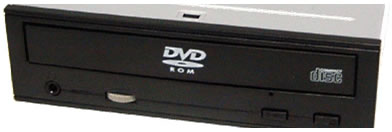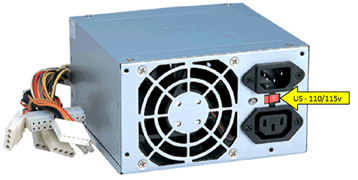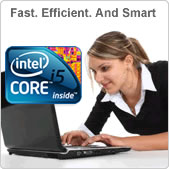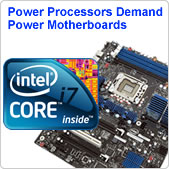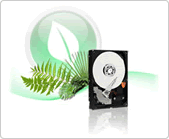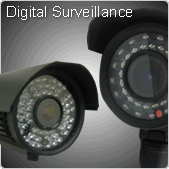 |
|
| Frequently Asked Questions |
|
1. MY COMPUTER RUNS SLOW 2. MY COMPUTER WON'T BOOT 3. I CANNOT PLAY A DVD 4. I HAVE NO INTERNET ACCESS 5. MY COMPUTER SHOWS NO SIGNS OF POWER 6. I HAVE NO SOUND 7. HOW TO VIEW DUAL MONITOR DISPLAY 8. MY HARD DRIVE ISN'T RECOGNIZED 9. MY COMPUTER DOESN'T SHOW THE TOTAL AMOUNT OF RAM INTALLED 10. I AM GETTING ERROR MESSAGES My Computer Is Slow Over time, a computer can become start to run slow. While this is frustrating, there are many possibilities that can cause this.
2. Low available disk space - Verify that there is at least 200-500MB of free hard disk drive space. This available space allows the computer to have room for the swap file to increase in size as well as room for temporary files. If you are low on space, you will need to add an additional hard drive or replace the existing drive. If you have adequate space, try running Scandisk or something equivalent to help ensure that there is nothing physically wrong with the computer hard disk drive. Try running Defrag to help ensure your data is arranged in the most efficient way. 3. Software trace files - Installing and uninstalling programs can result in trace files being left behind. These trace files can be confusing for other programs including windows causing things to slow down. Try running a cleaning program such as Ccleaner to optimize your computer. 4. Outdated drivers and updates - Make sure you have the latest windows updates and hardware drivers installed. Not doing so can result in a host of issues that can cause your pc to slow down. Verify with your PC manufacturer or hardware manufacturer that you are running the latest updates. 5. Computer is Overheating - If you haven't physically checked the inside of your pc in a while, it's a good idea to take a peek. Over time, dust, hair, and other objects can accumulate inside your pc and settle into your computer's lifeline, the fans. This can cause airflow interruption, fan failure, and ultimately hardware failure. Once a month you should clean out your computer and the fans with compressed air to ensure its getting proper cooling. Determine the temperature of your computer and CPU by checking the temperature in the bios. Check with your motherboard manufacturer for details on how to locate this. The majority of today's desktop processors should not exceed temperatures of 95°C and most will run between 70-90°C. If your temperatures are near or exceeding this, you will want to look at adding additional fans or replacing old ones. 6. Corrupted OS - If you are receiving occasional or frequent error messages in your OS, or getting random errors from various programs, it is likely that your OS installation has become corrupted. Many things can cause your windows files to become corrupt including hard resets, program installations / removal, file deletions, conflicting drivers and updates, and viruses and spyware. To correct a corrupt OS installation, it is necessary to reinstall or upgrade your operating system. You will need to backup your data before reinstalling to ensure its integrity. Contact our repair department for assistance if you are not experienced with OS installations. 7. Hardware Issues - Malfunctioning or outdated hardware can significantly slow things down inside your PC. Verify your hardware is malfunctioning properly in the device manager located under system properties in the control panel. If your workload has increased, upgrading your memory and/or CPU can also tremendously increase your PC speed. Contact our repair department to help you determine if your existing hardware can be upgraded. 8. Slow Internet - One of the biggest complaints with speed is while browsing or downloading on the internet. This speed is not so reliant upon your PC or hardware as much as the speed of your actual internet connection. If you are experiencing slow internet connectivity, you will want to contact your internet service provider to see what options are available to you. 9. If none of the above steps have resolved your issue, it is most likely a more critical problem. Call our knowledgeable repair technicians to setup an onsite appointment or bring your computer to our repair center for a comprehensive diagnosis. Back To Top My Computer Won't Boot 1. If your computer is powering up, but will not boot into windows there are several troubleshooting steps to follow. If you are receiving error codes, check the steps here. If you don't see any codes go to step 2. 2. Verify all cables inside and out are secure and properly connected. Old or frayed cables can cause the computer not to boot properly. Remove any external USB devices (flash drives, printers, scanners…etc) and try rebooting. 3. If you have just made a hardware change to your computer, verify your installation is correct and compatible with your system. If you installed a new motherboard, verify it's not grounded out by testing it on a piece of cardboard instead of screwed into the case. 4. Verify your memory is installed correctly and seated properly. Check with your motherboard manufacturer for compatible brands, speeds, and proper alignment. If your memory is seated properly, you may want to try booting with one stick at a time to verify the integrity. 5. Verify your CPU is seated properly and the fan is mounted tightly. If you just installed a new CPU or just reseated an old CPU, verify the correct amount of thermal paste is applied to ensure proper cooling. Boxed CPU fans usually come with the proper amount pre-applied to the heat sink and most likely will not require any additional. If you are reinstalling an old CPU, make sure you remove the old compound before applying new. Using too much can have an adverse effect on heat transfer. Thermal paste is (also called thermal gel, thermal compound, thermal grease, heat paste, heat sink paste, heat transfer compound, or heat sink compound) is a fluid substance which increases the thermal conductivity of a thermal interface by compensating for the irregular surfaces of the components. 6. Unplug all devices inside the computer that are not required for booting (CD drives, external hard drives, USB hubs and card readers, etc…). If it boots, try plugging the devices back in one by one to determine which of these are potentially problematic. 7. If none of the above steps have resolved your issue, it is most likely a more critical problem. Call our knowledgeable repair technicians to setup an onsite appointment or bring your computer to our repair center for a comprehensive diagnosis. Back To Top I Cannot Play A DVD
1. One of the most common complaints about an optical drive is not being able to watch a DVD from a computer. First thing is to verify your drive is capable of playing a DVD. Verify the specifications with the manufacturer. If you are unsure what brand and model you have, you can find out by looking in the device manager, located in the system properties in the control panel. 2. DVD playback requires a codec to be installed on your machine. Most drives include software to install the proper codec. If you have just installed a new drive, look through the included software for this. If your drive did not come with software or you cannot locate your disk, a K-lite codec package is available online as a free download. There are other software options available for purchase such as Power DVD or AVS Media Player. 3. If none of the above steps have resolved your issue, it is most likely a more critical problem. Call our knowledgeable repair technicians to setup an onsite appointment or bring your computer to our repair center for a comprehensive diagnosis. I Have No Internet Access 1. If you experiencing difficulties with your internet access, there are a few steps you can take to determine the source of the issue. First, check with your internet provider to determine if there have been any interruptions to your service. You will need to verify your modem/router are powered on and working. Make sure you are connected to the modem or the router by looking at your network properties. 2. If you are connected properly to your modem / router and still not getting internet access, you will want to try unplugging your modem / router for a few seconds then plug it back in. 3. If none of the above steps have resolved your issue, it is most likely a more critical problem. Call our knowledgeable repair technicians to setup an onsite appointment or bring your computer to our repair center for a comprehensive diagnosis. Back To Top My Computer Shows No Signs Of Power 1. Believe it or not, the number one reason why a computer won't turn on is because it wasn't turned on! Before starting a sometimes time consuming troubleshooting process, make sure you've turned on every power switch and power button on your computer:
3. Check for disconnected computer power cable connections. A loose or unplugged power cable is one of the top reasons why a computer doesn't turn on. 4. Verify power is being provided from the wall. Your computer isn't going to turn on if it's not getting power so you need to make sure that the power source is working properly. 5. At this point in your troubleshooting, it's very likely that the power supply unit in your computer is no longer working and should be replaced. You should however test it just to be sure. There's no reason to replace a working piece of hardware when testing it is fairly easy. Replace your power supply if it fails your testing. 6. If none of the above steps have resolved your issue, it is most likely a more critical problem. Call our knowledgeable repair technicians to setup an onsite appointment or bring your computer to our repair center for a comprehensive diagnosis. Back To Top I Have No Sound 1. If you are not getting sound from your computer and you have not made any hardware changes, you will first want to verify you have speakers plugged in to the proper port and are powered on. Make sure your volume is not turned down. If you are still experiencing difficulty getting sound, go to step 2. 2. Verify your sound card is actually being recognized by windows. Check this in the device manager located in system properties in the control panel and install the latest drivers from the manufacturer for your sound card. 3. If none of the above steps have resolved your issue, it is most likely a more critical problem. Call our knowledgeable repair technicians to setup an onsite appointment or bring your computer to our repair center for a comprehensive diagnosis. Back To Top How To View Dual Monitor Displays 1. Dual display is a feature on most video card options today. There are two main types of monitor connections on the video card, Digital (DVI) and Analog, although newer cards are coming out with an optional HDMI connector. Video card configurations vary so some will have two DVI connectors, some with two analog but most have one of each type. You may need a converter so verify what connectivity is required by your monitors. Not all video cards that have two connectors support dual monitor display so verify your card's capability with the manufacturer.
2. Once you have verified your card will support dual monitor display, and all cables and converters are installed properly, make sure the most current drivers are installed. Windows may automatically load some drivers but generic drivers may not enable all functionality on the card. Check with the chipset or card manufacturer to get the most recent drivers and firmware. 3. After confirming all drivers are installed, view your display properties in the control panel to adjust your dual view settings. 4. If none of the above steps have resolved your issue, it is most likely a more critical problem. Call our knowledgeable repair technicians to setup an onsite appointment or bring your computer to our repair center for a comprehensive diagnosis. Back To Top My Hard Drive Isn't Recognized 1. There are many hard drive issues that can arise. First verify your drive is powering up and the platters are spinning. If your hard drive is making a clicking sound, it is most likely in failure and you should replace the drive. If you are installing a new drive or moving a drive from one machine to another and your bios is not recognizing it, follow the steps below. 2. Verify all the cables are connected properly and fastened securely. Each hard drive requires one data cable, and one power cable. Some motherboards have RAID only ports, check with your motherboard manufacturer to verify your cables are plugged in to the proper port. 3. If installing Windows XP on a SATA hard drive, you may need to load additional drivers during the installation process. Check your motherboard manufacturer for details on creating a SATA driver disk. 4. Verify the proper jumpers for slave and master correspond to your cable and bios settings. This is especially important if you are using IDE drives. 5. If none of the above steps have resolved your issue, it is most likely a more critical problem. Call our knowledgeable repair technicians to setup an onsite appointment or bring your computer to our repair center for a comprehensive diagnosis. Back To Top My Computer Doesn't Show The Total Amount Of RAM Installed 1. Verify the amount of memory recognized by your motherboard by checking the amount displayed in the bios. Typically, you can just press the delete key at boot up to access the bios but if this doesn't work, check with your motherboard manufacturer for their specific details. If the amount displayed is less than what you installed, continue to step 2. If the total amount displayed in the bios is accurate but your OS is showing a less amount installed, skip to step 3. 2. Verify your memory is installed correctly and seated properly. Check with your motherboard manufacturer for compatible brands, speeds, maximum amounts and proper alignment. If your memory is seated properly, you may want to try booting with one stick at a time to verify the integrity. If you are adding memory you may want to remove the old ram and try booting with just the new. Sometimes different brands are not compatible running together in the same system. 3. If you are using an onboard video device, your motherboard may automatically designate a portion of your system ram for video ram. Check in the bios or with your motherboard manufacturer for video memory options. 4. Verify the operating system you are running supports the total amount of ram installed. Certain versions of Windows support a more limited amount of ram. Check the chart below. If you are running a different OS, check with that manufacturer for ram limitations.
5. If none of the above steps have resolved your issue, it is most likely a more critical problem. Call our knowledgeable repair technicians to setup an onsite appointment or bring your computer to our repair center for a comprehensive diagnosis. Back To Top I Am Getting Error MEssages Error messages are a frustrating experience. They can cause problems with just about any program or application running on your PC. They can be difficult to diagnose but one of the places to start is the internet. If you are receiving windows errors, or blue screens, check on Microsoft's support site for additional information. Another valuable source for determining error causes is your preferred search engine. Chances are, if you are having the error, someone else had it too and has posted information in cyberspace. Listed below are some common windows errors. For more information, contact our repair department.
Back To Top |
|

|
|
|
|
|||||||||||||||||||||||||||||||||||||||||

|
||||||||||||||||||||||||||||||||||||||||||||



